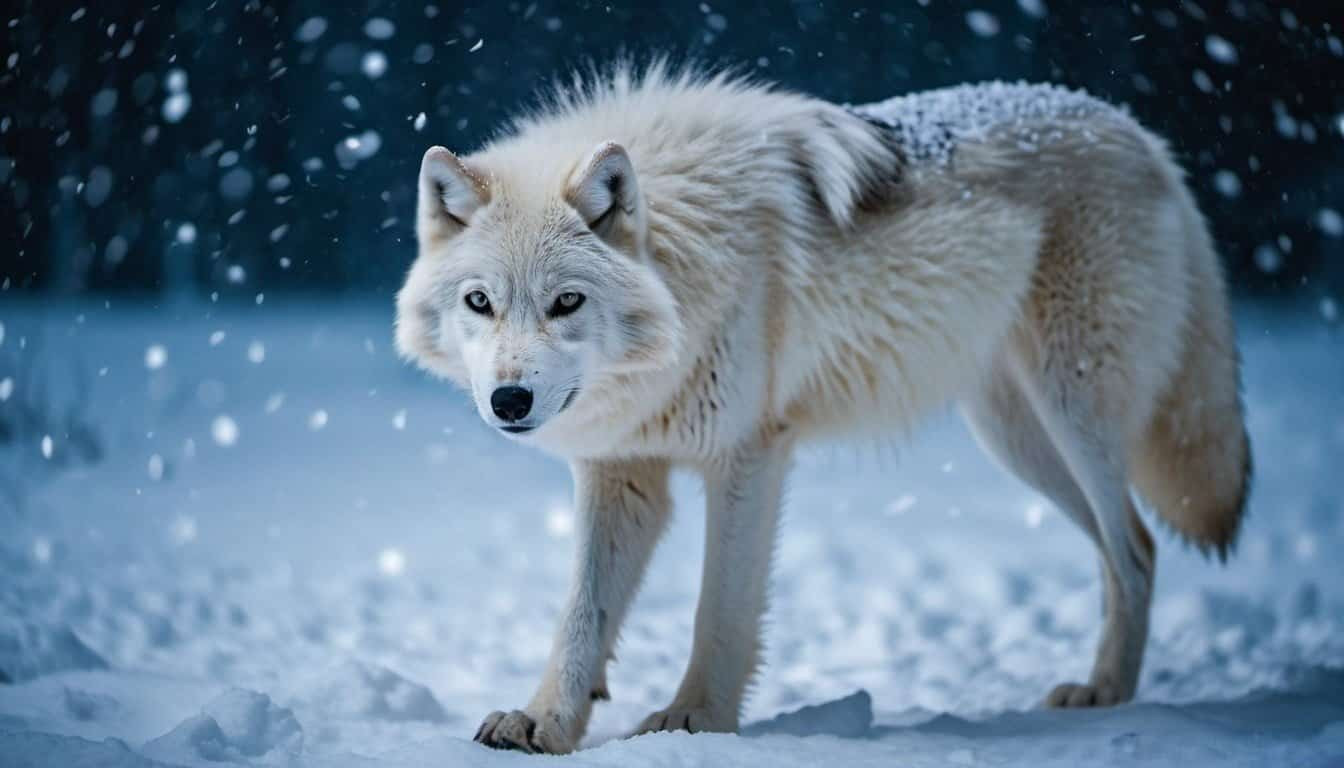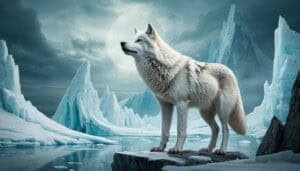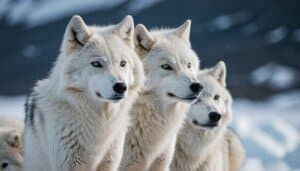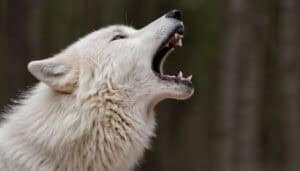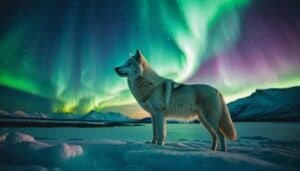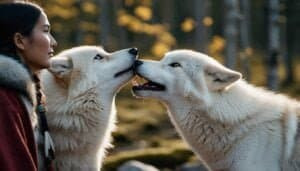Introduction
Arctic wolves are powerful symbols of resilience, embodying strength and endurance in the most hostile environments. Their ability to thrive in the harsh conditions of the Arctic not only highlights their physical adaptability but also their spiritual significance across various cultures
This article delves into the spiritual qualities attributed to arctic wolves, their demonstrations of resilience in their natural habitat, lessons humans can learn from their tenacity, and their role in indigenous spiritual beliefs
Join us as we explore how these magnificent creatures symbolize resilience in both a literal and spiritual sense
Spiritual Qualities Attributed to Arctic Wolves
Arctic wolves, often seen as symbols of resilience and strength, possess several spiritual qualities that have fascinated various cultures throughout history
These qualities not only reflect their physical capabilities but also their deeper, symbolic meanings
Symbolism of Strength and Endurance
The arctic wolf’s strength and endurance are central to its symbolism. These animals thrive in one of the world’s harshest environments, the Arctic, where temperatures can plummet below -30°F and food is scarce
Despite these challenges, arctic wolves are adept hunters, capable of traveling long distances to find food. This incredible endurance and tenacity make them powerful symbols of perseverance and strength in the face of adversity
In a spiritual context, the arctic wolf’s strength represents the inner power and resilience needed to overcome life’s obstacles. Many cultures see the wolf as a totem animal, embodying the qualities of courage, determination, and survival
The wolf’s ability to endure harsh conditions without faltering mirrors the human spirit’s capacity to withstand and triumph over personal challenges. This symbolism encourages individuals to harness their inner strength and remain steadfast, no matter how difficult their circumstances may be
Representation in Various Cultures
The arctic wolf holds significant spiritual meaning in various cultures, each interpreting the animal’s traits in unique ways
In Native American traditions, for instance, the wolf is often revered as a teacher and pathfinder. It is believed that wolves have a deep connection with the spiritual realm and can guide individuals on their spiritual journeys
The arctic wolf, with its ability to navigate the desolate Arctic landscape, symbolizes guidance and wisdom, offering spiritual insight to those who seek it
In Inuit culture, the arctic wolf is a symbol of the land and survival. Inuit myths often portray the wolf as a powerful and mystical creature that can communicate with humans and the spirit world. This connection underscores the wolf’s role as a mediator between the physical and spiritual realms, bridging the gap and providing valuable lessons on living harmoniously with nature
In Celtic mythology, the wolf is associated with the moon and the night, representing mystery and the unknown. The arctic wolf, surviving in the perpetual darkness of the polar night, embodies these qualities
This symbolism teaches the importance of embracing the unknown and finding strength in mystery and solitude. The wolf’s presence in these myths highlights its role as a guardian of secrets and a symbol of inner strength that flourishes even in the darkest times
Demonstrations of Resilience in the Natural Habitat
Arctic wolves are remarkable examples of resilience, thriving in the extreme conditions of the Arctic tundra. Their ability to adapt and survive in such a harsh environment showcases their exceptional resilience and determination
This section explores the various ways in which arctic wolves demonstrate resilience in their natural habitat
Adaptations to Harsh Environments
Arctic wolves have developed several physical and behavioral adaptations that enable them to survive in the extreme conditions of the Arctic
Their thick, double-layered coats provide excellent insulation against the cold, while their compact bodies reduce heat loss. The outer layer of their fur repels water and ice, keeping them dry and warm. Additionally, their paws are covered with fur, which acts as natural snowshoes, allowing them to walk on snow and ice without slipping
Behaviorally, arctic wolves are highly adaptable hunters. They have been known to travel up to 20 miles a day in search of food, relying on their keen senses and cooperative pack behavior to track and hunt prey
Their primary diet consists of muskoxen, Arctic hares, and caribou, but they are opportunistic feeders and will eat smaller animals and scavenged remains when necessary. This flexibility in diet is a crucial adaptation that helps them survive periods of food scarcity
Arctic wolves also exhibit remarkable social resilience. They live in packs that are typically smaller than those of their southern relatives, often consisting of a mated pair and their offspring. This close-knit social structure ensures cooperation and support, enhancing their ability to hunt and care for young in the challenging Arctic environment
Survival Strategies in Extreme Conditions
Arctic wolves employ various survival strategies to endure the extreme conditions of their habitat. During the long, dark winters, they rely on their fat reserves and reduced metabolic rates to conserve energy
They are capable of fasting for several days when food is scarce, a crucial survival strategy in a region where prey can be elusive
Their hunting techniques also reflect their resilience. Arctic wolves often hunt in packs, using strategic coordination and teamwork to take down large prey like muskoxen. This collaborative hunting approach increases their chances of a successful kill, ensuring that all pack members have enough food to survive
Additionally, they have been observed caching food, hiding surplus meat in the snow to eat later when hunting conditions are not favorable
The wolf’s denning behavior is another critical aspect of their survival strategy. Arctic wolves dig dens in the ground or find shelter in caves to protect their young from the cold and predators. These dens are carefully constructed and insulated, providing a safe and warm environment for raising pups during the harsh Arctic spring
Environmental Threats
Despite their incredible adaptations and survival strategies, arctic wolves face significant environmental threats that challenge their resilience
Climate change is one of the most pressing issues, as rising temperatures and melting ice alter their habitat and disrupt prey availability. These changes can lead to food shortages and increased competition with other predators, putting additional stress on arctic wolf populations
Human activities also pose threats to arctic wolves. Increased oil and gas exploration, mining, and infrastructure development in the Arctic can fragment their habitat and disrupt migration patterns. These activities can lead to habitat loss and increased human-wolf conflicts, further endangering their survival
Arctic wolves also face threats from diseases and parasites, which can spread more easily as climate change impacts the Arctic ecosystem. As temperatures rise, new pathogens and parasites may move into the region, posing health risks to wolf populations that have not previously encountered these threats
Lessons from Arctic Wolves for Human Resilience
Arctic wolves, with their remarkable ability to thrive in some of the planet’s most extreme environments, offer profound lessons in resilience. Their behaviors and adaptations can inspire humans to develop greater resilience in the face of life’s challenges
This section explores how the spiritual qualities of arctic wolves can be translated into practical lessons for human resilience
Spiritual Practices Inspired by Wolves
Many spiritual traditions and practices draw inspiration from the behaviors and qualities of wolves, particularly arctic wolves. These practices emphasize the importance of resilience, community, and adaptation—traits that are essential for surviving and thriving in difficult conditions
Meditation and visualization techniques often incorporate the imagery of the wolf to foster a sense of inner strength and perseverance. Practitioners may visualize themselves as a wolf navigating through a harsh landscape, drawing on the animal’s endurance and adaptability to overcome personal challenges
This type of meditation helps build mental and emotional resilience, encouraging individuals to stay focused and calm even in the face of adversity
Rituals and ceremonies in various cultures also use the symbolism of the wolf to invoke resilience and strength. For example, some Native American tribes perform wolf dances and other ceremonial practices to honor the wolf spirit and seek its guidance. These rituals emphasize the importance of community support and collective strength, reflecting the pack dynamics of arctic wolves
Applying Wolf-like Resilience in Daily Life
Arctic wolves’ strategies for survival can be applied to human life, offering valuable lessons in resilience and adaptability. Here are some practical ways to incorporate wolf-like resilience into daily life:
Adaptability: Just as arctic wolves adapt their hunting strategies and diets based on availability, humans can develop resilience by being flexible and open to change. Embracing new opportunities and adjusting plans when faced with obstacles can enhance one’s ability to navigate life’s challenges
Community and Support: Arctic wolves rely on their pack for survival, demonstrating the power of cooperation and mutual support. Building a strong support network of friends, family, and colleagues can provide emotional and practical assistance during tough times. Leaning on others and offering support in return strengthens resilience and fosters a sense of belonging
Endurance: The physical endurance of arctic wolves, such as their ability to travel long distances in search of food, mirrors the mental and emotional endurance needed to persist through challenges. Developing habits that promote physical health, such as regular exercise and proper nutrition, can enhance overall resilience. Additionally, practicing mindfulness and stress management techniques can build mental endurance and reduce the impact of stress
Resourcefulness: Arctic wolves demonstrate resourcefulness by making the most of available resources, whether it’s hunting strategies or finding shelter. Humans can cultivate resilience by being resourceful and creative in problem-solving. Approaching challenges with a mindset focused on solutions rather than obstacles can lead to innovative and effective outcomes
Persistence: Arctic wolves often face scarcity and harsh conditions, yet they persist in their efforts to survive. Similarly, humans can develop resilience by maintaining a persistent attitude, even when progress seems slow or setbacks occur. Setting small, achievable goals and celebrating incremental successes can help maintain motivation and forward momentum
By observing and learning from the resilience of arctic wolves, humans can develop their own strategies for overcoming adversity. These lessons, grounded in the natural world and spiritual symbolism, provide a powerful framework for building inner strength and adaptability
Arctic Wolves in Indigenous Spiritual Beliefs
Arctic wolves hold significant roles in the spiritual beliefs and traditions of various indigenous cultures. These wolves are often seen as symbols of strength, guidance, and survival, embodying qualities that resonate deeply within these communities
This section explores the myths, legends, and cultural roles of arctic wolves in indigenous spirituality
Myths and Legends
Many indigenous cultures have rich mythologies that feature arctic wolves as central figures. These stories often highlight the wolf’s role as a guardian, teacher, and symbol of resilience
In Inuit mythology, the arctic wolf is often depicted as a powerful and mystical creature. One popular Inuit legend tells of Amarok, a gigantic wolf that hunts alone and is believed to protect the land and its people
Amarok is seen as a symbol of strength and courage, embodying the qualities needed to survive in the harsh Arctic environment. This legend underscores the respect and reverence that the Inuit people have for the arctic wolf, seeing it as both a protector and a source of wisdom
Similarly, in some Native American traditions, the arctic wolf is revered as a spirit animal and guide. Wolves are often seen as teachers, imparting important lessons about living in harmony with nature and each other. The arctic wolf’s ability to endure harsh conditions and maintain social bonds within its pack is seen as an inspiration for humans to cultivate resilience, cooperation, and community
Role in Indigenous Cultures
The arctic wolf’s spiritual significance extends beyond myths and legends to its role in the daily lives and cultural practices of indigenous peoples. For many indigenous communities, the wolf is a totem animal, representing qualities that individuals and the community as a whole aspire to embody
In Inuit culture, the wolf is not only a symbol of survival but also a guide in hunting and navigation. Inuit hunters often look to the wolf’s behavior for cues about the presence of prey and changing weather conditions
The arctic wolf’s keen senses and ability to find food in the most challenging environments make it a valuable teacher for those living in the Arctic
Additionally, the wolf features prominently in rituals and ceremonies. For instance, some Native American tribes include wolf dances in their spiritual practices. These dances celebrate the wolf’s spirit and seek to invoke its strength and resilience
Participants often wear wolf masks and costumes, embodying the animal’s characteristics and seeking to draw its energy and guidance into their lives
Conservation Efforts
Recognizing the importance of the arctic wolf in indigenous spirituality and cultural heritage, many indigenous communities are actively involved in conservation efforts to protect these animals and their habitats
Climate change and human activities pose significant threats to the Arctic ecosystem, and indigenous peoples are at the forefront of advocating for sustainable practices and environmental stewardship
Indigenous knowledge and traditional ecological practices play a crucial role in conservation strategies. For example, many indigenous communities engage in monitoring wildlife populations and environmental changes, providing valuable data that can inform conservation policies
Their deep connection to the land and its inhabitants allows them to offer unique insights into the needs and behaviors of arctic wolves
Collaborative conservation efforts between indigenous communities, governments, and environmental organizations aim to preserve the delicate balance of the Arctic ecosystem
These initiatives not only protect the arctic wolf but also ensure the continuation of the cultural and spiritual traditions that are intertwined with the wolf’s existence
Conclusion
Arctic wolves, thriving in one of the world’s harshest environments, serve as profound symbols of resilience and strength
Their physical adaptations and social behaviors enable them to withstand extreme cold and scarcity, while their spiritual significance across various cultures underscores their role as teachers of endurance and perseverance. Indigenous myths and legends celebrate the arctic wolf as a guardian and guide, embodying qualities that resonate deeply within these communities
Through their remarkable survival strategies, arctic wolves demonstrate key lessons in adaptability, community support, and persistence. These lessons inspire humans to cultivate similar resilience in their own lives, emphasizing the importance of flexibility, strong social networks, and mental endurance
Furthermore, the spiritual practices and cultural roles of arctic wolves highlight their significance in indigenous beliefs, where they are revered as totem animals and integral parts of rituals and ceremonies
Indigenous-led conservation efforts are crucial in protecting these majestic animals and preserving the rich cultural heritage they represent
By understanding and appreciating the resilience of arctic wolves, we gain valuable insights into our own capacity for endurance and adaptability, fostering a deeper connection to the natural world and the spiritual lessons it offers
